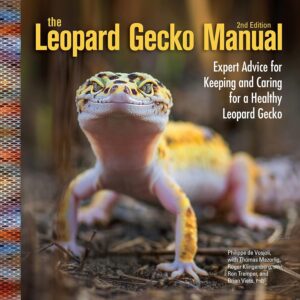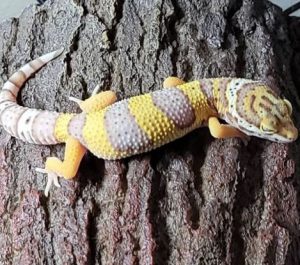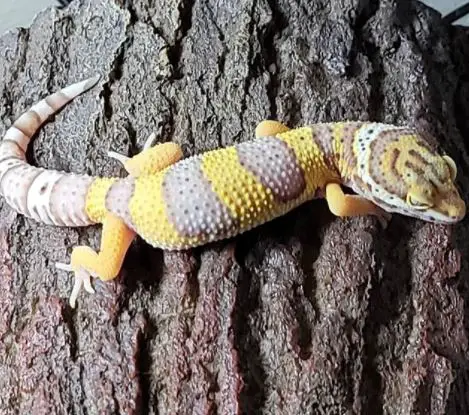Overweight leopard gecko
Overweight leopard gecko: Leopard geckos, with their enchanting patterns and gentle demeanor, have become increasingly popular as pets among reptile enthusiasts. These small, nocturnal lizards are native to the arid regions of Afghanistan, Pakistan, and northwest India. Known for their distinctive fat tails and unique ability to vocalize through chirping sounds, leopard geckos have captivated the hearts of pet owners around the world.
Brief Overview of Leopard Geckos as Pets
Leopard geckos make excellent pets for both novice and experienced reptile keepers. They are relatively easy to care for and have a lifespan of approximately 10 to 20 years when provided with proper husbandry. Unlike many other reptiles, leopard geckos do not require UVB lighting as they obtain their necessary vitamin D3 from their diet.
These captivating creatures are typically small in size, measuring between 6 to 10 inches in length when fully grown. Their skin is adorned with intricate patterns that vary in coloration from vivid yellows and oranges to earthy browns and blacks.
One fascinating aspect of leopard geckos is their ability to shed their skin in one piece. Leopard geckos have gained popularity due to their docile nature and ease of handling.
Unlike some reptiles that can be skittish or prone to biting when startled or threatened, leopard geckos tend to be calm and tolerant towards human interaction. This makes them ideal companions for individuals seeking a low-maintenance pet that offers opportunities for gentle handling.
Introduction to the Topic of Overweight Leopard Geckos
 While it may seem surprising that such small creatures can become overweight, obesity can indeed affect leopard geckos just like any other living being. Overweight or obese leopard geckos occur when an imbalance is present between energy intake (food consumed) and energy expenditure (physical activity).
While it may seem surprising that such small creatures can become overweight, obesity can indeed affect leopard geckos just like any other living being. Overweight or obese leopard geckos occur when an imbalance is present between energy intake (food consumed) and energy expenditure (physical activity).
Unfortunately, the prevalence of overweight leopard geckos is on the rise due to improper feeding practices and lack of awareness among owners. Addressing the issue of overweight leopard geckos is crucial as obesity can lead to a myriad of health problems, reducing their overall quality of life and potentially shortening their lifespan.
In this article, we will delve into the causes contributing to overweight leopard geckos, the potential health risks associated with obesity in these reptiles, and strategies for successfully managing their weight. By understanding the root causes and implementing appropriate interventions, we can ensure that our beloved leopard geckos remain healthy and thrive in captivity.
Description of Leopard Geckos’ Natural Habitat and Behavior
Leopard geckos (Eublepharis macularius) are fascinating reptiles native to the arid regions of Iran, Afghanistan, Pakistan, and parts of India. In their natural habitat, they inhabit rocky deserts and arid grasslands where they have adapted to survive in extreme temperatures ranging from scorching hot during the day to quite cold at night. These resilient creatures have developed unique characteristics that allow them to thrive in such environments.
Leopard geckos are known for their distinctive appearance, featuring a stocky body covered in bumpy skin with various patterns and colors. They possess unique eyelids that can close entirely for protection against sand or dust.
As nocturnal animals, they rely on excellent vision under low light conditions. They have specialized toes equipped with tiny claws that enable them to navigate various terrains effortlessly.
In their natural habitat, leopard geckos exhibit solitary behavior and tend to be territorial. They are primarily ground-dwelling creatures but can also climb rocks or small plants when necessary.
These geckos are famous for their ability to shed their tails as a defense mechanism against predators. Additionally, they have a remarkable ability to store fat reserves in their tail as an energy source during periods of food scarcity.
Discussion on Their Diet and Feeding Habits
Understanding the dietary needs of leopard geckos is crucial for ensuring their well-being in captivity. In the wild, these geckos feed primarily on insects such as crickets, mealworms, waxworms, and locusts.
It is essential for owners to replicate this diet as closely as possible when feeding them in captivity. A balanced diet for leopard geckos should consist mainly of gut-loaded insects supplemented with occasional treats such as pinkie mice or juvenile rats (in moderation).
Gut-loading refers to feeding nutritious foods to the insects before offering them to the geckos, ensuring they receive optimal nutritional value. Calcium and vitamin D3 supplementation are also vital for maintaining their health, as these reptiles require sufficient amounts of calcium for proper bone development.
Feeding frequency varies based on the age and size of the leopard gecko. Juveniles should be fed daily, while adults can be fed every other day or every two days.
It is crucial not to overfeed these reptiles, as obesity can lead to various health complications. Monitoring their body condition regularly is essential to ensure they maintain a healthy weight.
Overall, understanding the natural habitat and behavioral traits of leopard geckos allows owners to provide an appropriate diet that mimics their natural feeding patterns. By replicating their native environment as closely as possible and offering a balanced diet with adequate supplementation, owners can help ensure the optimal health and well-being of these remarkable creatures in captivity.
Causes of Overweight Leopard Geckos
Overfeeding and Improper Diet Choices
One of the primary causes of overweight leopard geckos is overfeeding and offering an improper diet. Leopard geckos are insectivores, meaning their diet should consist mainly of live insects.
However, many owners tend to overfeed their geckos, providing larger portions than necessary or offering food too frequently. This excess intake of food leads to weight gain and can have detrimental effects on their health.
To maintain a healthy weight, it is essential to understand the ideal diet for leopard geckos. Their primary food source should be gut-loaded insects such as crickets, mealworms, and dubia roaches.
These insects should be dusted with calcium and vitamin D3 supplements before being fed to the gecko. The calcium helps in maintaining proper bone health, while vitamin D3 aids in proper absorption of calcium.
Common Mistakes Made by Owners in Feeding Their Geckos
Despite having knowledge about the ideal diet for leopard geckos, owners often make mistakes when it comes to feeding their pets. One common mistake is relying solely on one type of insect as the staple food source. Variety is crucial as different insects offer varying nutritional values.
Additionally, some owners may overlook gut-loading the insects with nutritious foods before feeding them to the gecko, leading to an inadequate nutrient intake. Another mistake is over-reliance on commercial reptile diets or pellet foods instead of live insects.
While these products may provide some nutrients, they lack the natural benefits and stimulation derived from hunting live prey. Moreover, these processed foods often contain high levels of fillers or preservatives that can contribute to weight gain if not monitored closely.
Lack of Exercise and Inadequate Enclosure Setup
 Apart from overfeeding, the lack of exercise and an inadequate enclosure setup can also contribute to leopard geckos becoming overweight. These reptiles require a stimulating environment that encourages physical activity to keep them fit and healthy. Providing an enriching enclosure is crucial in combating obesity.
Apart from overfeeding, the lack of exercise and an inadequate enclosure setup can also contribute to leopard geckos becoming overweight. These reptiles require a stimulating environment that encourages physical activity to keep them fit and healthy. Providing an enriching enclosure is crucial in combating obesity.
The enclosure should be spacious enough for the gecko to move around freely, with hiding spots, climbing opportunities, and varied textures such as rocks or branches for stimulation. Including multiple levels or platforms within the enclosure can encourage vertical movement and exercise.
Owners should also consider setting up a separate feeding area within the enclosure. This ensures that the gecko associates only one specific spot with receiving food, preventing constant grazing throughout the habitat.
By separating their feeding area from their resting or hiding areas, it helps regulate their food intake and promotes a more active lifestyle. Creating an enriching environment for leopard geckos not only promotes physical activity but also provides mental stimulation.
This reduces boredom and stress-related behaviors that may lead to overeating or sedentary habits. By addressing both diet-related causes and environmental factors contributing to overweight leopard geckos, owners can help their pets maintain a healthy weight and overall well-being.
Identifying an Overweight Leopard Gecko
Physical signs and symptoms to look out for
When it comes to identifying whether a leopard gecko is overweight, there are specific physical signs and symptoms to observe. One of the primary indicators is an excessive amount of body fat or a bulging appearance. Observe the gecko’s body contours and look for any areas where there may be an abnormal accumulation of fat.
Additionally, check if the gecko has difficulty moving or shows signs of lethargy. These can be signs that their excess weight is affecting their mobility and overall energy levels.

Comparison to a healthy weight leopard gecko
To determine if your leopard gecko is overweight, it’s crucial to understand what constitutes a healthy weight in these reptiles. A healthy body condition score arises from proper care, diet, and regular exercise.
A lean and fit leopard gecko should have defined muscularity with minimal visible fat deposits. By examining the visual cues of a healthy specimen, such as clear muscle definition around the limbs and tail base, you can compare them to your own gecko’s physique.
Description of a healthy body condition score
A reliable method for assessing the body condition score (BCS) in leopard geckos involves careful observation and interpretation. Ideally, you want your pet to fall within BCS 4-5 on a scale of 1-9, where 1 indicates emaciation and 9 represents obesity.
In this range, their tails should appear plump but not overly fatty or thin with visible bone structure underneath. Similarly, their bodies should exhibit gentle curves without excessive fat deposits along the back or abdomen.
Health Risks Associated with Obesity in Leopard Geckos
Impact on overall health and lifespan
Obesity in leopard geckos can have significant implications for their overall health and lifespan. Excess weight puts additional strain on the gecko’s body, leading to a variety of health issues. One of the most concerning consequences is an increased risk of developing metabolic bone disease (MBD), which negatively affects their bone density and overall skeletal structure.
Furthermore, the excess fat can stress their internal organs, potentially resulting in organ dysfunction or failure. In severe cases, obesity can even reduce a gecko’s reproductive capabilities, impacting their ability to breed successfully.
Increased risk of metabolic bone disease (MBD)
Metabolic bone disease (MBD) is a prevalent concern among overweight leopard geckos due to the strain excess weight places on their skeletal system. MBD refers to a range of disorders that affect the proper development and maintenance of bones and connective tissues.
The imbalanced calcium-to-phosphorus ratio resulting from poor diet choices in overweight geckos exacerbates this condition further. As MBD progresses, it can cause deformities, fractures, mobility issues, and even life-threatening complications.
Reduced reproductive capabilities
Another adverse effect of obesity in leopard geckos relates to their reproductive capabilities. Overweight females may experience difficulties with ovulation or producing healthy eggs due to hormonal imbalances caused by excessive body fat. Similarly, overweight males may have reduced fertility or struggle with mating behavior due to decreased energy levels and compromised overall health.
Treating Overweight Leopard Geckos
Consultation with a reptile veterinarian
When dealing with an overweight leopard gecko, it is essential not to undertake weight management without professional guidance from a reptile veterinarian experienced in exotic pet care. They will conduct a thorough examination of your gecko’s health and provide tailored advice based on its individual needs.
Discussion on potential dietary changes or restrictions
One aspect of treating overweight leopard geckos involves making appropriate dietary changes. The veterinarian may recommend a modified feeding schedule, portion control, or adjusting the types of food offered to ensure a balanced diet suitable for weight loss. It is important to avoid drastic caloric restrictions or sudden changes that could further stress the gecko’s metabolism.
Encouraging exercise and physical activity
To aid in weight management, it is crucial to encourage exercise and physical activity for your leopard gecko. Providing an enriching enclosure with various climbing structures and hiding spots can stimulate natural behaviors that promote movement. Additionally, engaging in guided playtime sessions with your gecko under controlled conditions can help increase their overall activity levels.
To sum up overweight leopard gecko
Identifying an overweight leopard gecko requires careful observation of physical signs such as excessive body fat and reduced mobility. Understanding the risks associated with obesity is crucial for their well-being since it can lead to health complications such as metabolic bone disease, organ stress, and reproductive difficulties.
Treating an overweight leopard gecko should always involve seeking professional advice from a reptile veterinarian who can guide you on appropriate dietary adjustments and encourage exercise. By addressing these concerns proactively, we have the opportunity to enhance our geckos’ quality of life and provide them with a bright future full of vitality and happiness.


